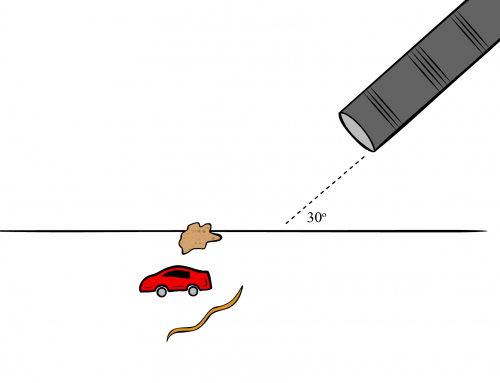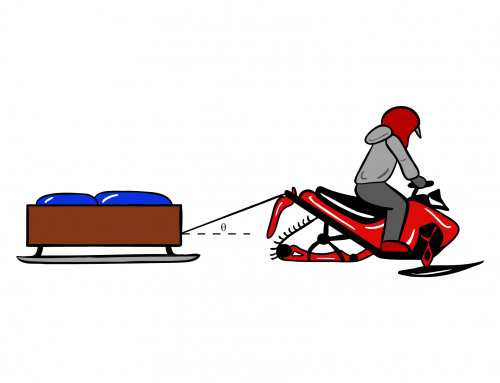A round up in an amusement park has a radius of \(6\,\text{m}\) and a constant angular velocity of \(4\,\text{rad/s}\). The round up’s angle of inclination is \(40^{\circ}\). The coefficient of static friction between the round up and a rider is \(0.3\). The round up allows a person of \(70\,\text{kg}\) to be held against the wall without touching the ground with their feet. Ignore the force caused by the seat belts.
a) Calculate the force that the round up exerts on the rider at its highest point.
b) Calculate the force that the round up exerts on the rider at its lowest point.
c) What is the minimum velocity that the round up needs to keep a person without seat belt from falling to the floor?
a) The round-up exerts two forces on the rider: a normal force \(\vec{N}\) perpendicular to the surface on which the person rests his back and a friction force \(\vec{F}_r\) that counters the weight and allows the rider to not touch the ground with his feet.
Let’s make a force diagram that considers all the forces exerted on the rider: the normal \(\vec{N}\), the friction \(\vec{F}_r\), and the person’s weight \(\vec{W}\). We place the coordinate axis so that it points in the direction of the round up center and Y points in the same direction as the friction, as seen in the Figure.
Now we can use Newton’s second law
\begin{equation}\label{n1}
\sum \vec{F}=m\vec{a},
\end{equation}
where \(m\) is the mass of the person, \(\vec{a}\) is the acceleration vector for the person, and \(\sum \vec{F}\) is the sum of all forces. Summing up the three forces described on the left side of equation \eqref{n1}, we obtain
\begin{equation}\label{n2}
\vec{N}+\vec{W}+\vec{F}_r=m\vec{a}.
\end{equation}
The vector equation in \eqref{n2} could be decomposed and written in terms of their components. For the component along the X axis, we have the normal force \(\vec{N}\) and a component of the weight \(\vec{W}\), which could be calculated using the angle \(\theta\), the angle of the round-up inclination. Writing the expression for the X axis that follows from equation \eqref{n2}, we have
\begin{equation}\label{nx}
N\,\hat{\textbf{i}}+mg\sin(\theta)\,\hat{\textbf{i}}=ma_c\,\hat{\textbf{i}},
\end{equation}
where \(N\) is the magnitude of the normal force, \(g\) is the gravitational acceleration on Earth, and \(mg\) is the magnitude of the weight force. Along this axis, we have the centripetal acceleration \(a_c\) directed towards the center in the same direction as \(\vec{N}\). The centripetal acceleration can be calculated in terms of the angular velocity \(\omega\) and the radius \(R\) of the round up:
\begin{equation}\label{cent}
a_c=\omega^2R.
\end{equation}
Using the expression for the centripetal acceleration given in \eqref{cent} into equation \eqref{nx}, we get
\begin{equation}
N\,\hat{\textbf{i}}+mg\sin(\theta)\,\hat{\textbf{i}}=m\omega^2R\,\hat{\textbf{i}},
\end{equation}
where we can solve for \(N\) to obtain
\begin{equation}\label{norm}
N\,\hat{\textbf{i}}=m\omega^2R\,\hat{\textbf{i}}-mg\sin(\theta)\,\hat{\textbf{i}}.
\end{equation}
Using the numerical values, we get
\begin{equation}
N\,\hat{\textbf{i}}=(70\,\text{kg})(4\,\text{rad/s})^2(6\,\text{m})\,\hat{\textbf{i}}-(70\,\text{kg})(9.8\,\text{m/s}^2)\sin(40^{\circ})\,\hat{\textbf{i}},
\end{equation}
\begin{equation}\label{norm1}
N\,\hat{\textbf{i}}\approx 6279\,\text{N}\,\hat{\textbf{i}}.
\end{equation}
To find the friction force, we could write the component along the Y axis of equation \eqref{n2}. Along the Y axis, there is no acceleration, and the only forces are the friction and a component of the weight. So, we can write,
\begin{equation}
-mg\cos(\theta)\,\hat{\textbf{j}}+ F_r\,\hat{\textbf{j}}=0\,\hat{\textbf{j}},
\end{equation}
which is equivalent to
\begin{equation}\label{friction}
F_r\,\hat{\textbf{j}}=mg\cos(\theta)\,\hat{\textbf{j}}.
\end{equation}
Using the numerical values, we have
\begin{equation}
F_r\,\hat{\textbf{j}}=(70\,\text{kg})(9.8\,\text{m/s}^2)\cos(40^{\circ})\,\hat{\textbf{j}},
\end{equation}
\begin{equation}
F_r\,\hat{\textbf{j}}\approx 525.5\,\text{N}\,\hat{\textbf{j}}.
\end{equation}
We only have to verify that the value of the friction that we found is less than the maximum friction \(F_{rmax}\), which is
\begin{equation}
F_{rmax}=\mu_s N,
\end{equation}
where \(\mu_s\) is the static coefficient of friction. Numerically, the maximum friction is
\begin{equation}
F_{rmax}=(0.3)(6279\,\text{N}),
\end{equation}
\begin{equation}
F_{rmax}=1883\,\text{N}.
\end{equation}
Because \(F_r<F_{rmax}\), the person does not move along the Y axis, as we assumed at the beginning of the problem.
b) We must follow the same steps to calculate the normal force \(\vec{N}\) and friction force \(\vec{F}_r\) on the lowest point of the round up. Let’s start by making a force diagram, as seen in the figure.
Notice that we changed the direction of the positive X axis in our coordinate system. It’s always convenient to make it coincide with the direction towards the center of the circular motion so that the centripetal acceleration will be positive.
Newton’s second law as written in equation \eqref{n2} in its vector form is still valid because the same three forces are exerted, but some of their directions and magnitudes have changed. Writing only the component along the X axis of equation \eqref{n2} in this new configuration gives
\begin{equation}
N\,\hat{\textbf{i}}-mg\sin(\theta)\,\hat{\textbf{i}}=ma_c\,\hat{\textbf{i}},
\end{equation}
where we can use the expression for the centripetal acceleration given in \eqref{cent} to obtain
\begin{equation}
N\,\hat{\textbf{i}}-mg\sin(\theta)\,\hat{\textbf{i}}=m\omega^2R\,\hat{\textbf{i}}.
\end{equation}
Solving for \(N\) in the equation above, we get
\begin{equation}
N\,\hat{\textbf{i}}=m\omega^2R\,\hat{\textbf{i}}+mg\sin(\theta)\,\hat{\textbf{i}}.
\end{equation}
Using the numerical values, we get
\begin{equation}
N\,\hat{\textbf{i}}=(70\,\text{kg})(4\,\text{rad/s})^2(6\,\text{m})\,\hat{\textbf{i}}+(70\,\text{kg})(9.8\,\text{m/s}^2)\sin(40^{\circ})\,\hat{\textbf{i}},
\end{equation}
\begin{equation}\label{norm2}
N\,\hat{\textbf{i}}\approx 7161\,\text{N}\,\hat{\textbf{i}}.
\end{equation}
To find the friction force, we could write the component along the Y axis of equation \eqref{n2}. Along the Y axis, there is no acceleration, and the only forces are the friction and a component of the weight. So, we can write,
\begin{equation}
-mg\cos(\theta)\,\hat{\textbf{j}}+ F_r\,\hat{\textbf{j}}=0\,\hat{\textbf{j}},
\end{equation}
which is equivalent to
\begin{equation}
F_r\,\hat{\textbf{j}}=mg\cos(\theta)\,\hat{\textbf{j}}.
\end{equation}
Using the numerical values, we have
\begin{equation}
F_r\,\hat{\textbf{j}}=(70\,\text{kg})(9.8\,\text{m/s}^2)\cos(40^{\circ})\,\hat{\textbf{j}},
\end{equation}
\begin{equation}
F_r\,\hat{\textbf{j}}\approx 525.5\,\text{N}\,\hat{\textbf{j}}.
\end{equation}
We only have to verify that the value of the friction found is less than the maximum friction \(F_{rmax}\), which is
\begin{equation}
F_{rmax}=\mu_s N,
\end{equation}
where \(\mu_s\) is the static coefficient of friction. Numerically, the maximum friction is
\begin{equation}
F_{rmax}=(0.3)(7161\,\text{N}),
\end{equation}
\begin{equation}
F_{rmax}\approx2148\,\text{N}.
\end{equation}
Because \(F_r<F_{rmax}\), the person does not move along the Y axis as we assumed at the beginning of the problem.
c) The critical point at which a person could leave the round up is at the highest point because the normal force is less (compare \eqref{norm1} and \eqref{norm2}), and thus the maximum friction force \(F_{rmax}\) is less and can be surpassed by the component of the weight. For the critical velocity, we’ll write the condition for the static friction for the person to not slip to the ground, which is
\begin{equation}\label{cond}
F_{r}\leq \mu_s N.
\end{equation}
Using the expressions for \(F_r\) and \(N\) given by equations \eqref{norm} and \eqref{friction} into equation \eqref{cond}, and dropping the unitary vector notation, we get
\begin{equation}
mg\cos(\theta)\leq \mu_s \left(m\omega^2R-mg\sin(\theta)\right).
\end{equation}
Canceling out the mass \(m\) in the expression above because it’s present in all terms, we get
\begin{equation}
g\cos(\theta)\leq \mu_s\left(\omega^2R-g\sin(\theta)\right).
\end{equation}
Now we want to solve for \(\omega^2\) in the inequality above. So, we divide both sides by \(\mu_s\) to get
\begin{equation}
\frac{g\cos(\theta)}{\mu_s}\leq \omega^2R-g\sin(\theta),
\end{equation}
which is equivalent to
\begin{equation}
\frac{g\cos(\theta)}{\mu_s}+g\sin(\theta)\leq \omega^2R.
\end{equation}
Dividing both sides by \(R\) in the expression above, we find that
\begin{equation}
\frac{g\cos(\theta)}{\mu_s R}+\frac{g\sin(\theta)}{R}\leq \omega^2,
\end{equation}
and taking the square-root on both sides
\begin{equation}\label{ineq}
\sqrt{\frac{g\cos(\theta)}{\mu_s R}+\frac{g\sin(\theta)}{R}}\leq \omega.
\end{equation}
So, the minimum angular velocity \(\omega_{min}\) is found when the inequality in \eqref{ineq} is an equality, that is
\begin{equation}
\omega_{min}=\sqrt{\frac{g\cos(\theta)}{\mu_s R}+\frac{g\sin(\theta)}{R}}.
\end{equation}
Using the numerical values, we find that
\begin{equation}
\omega_{min}=\sqrt{\frac{(9.8\,\text{m/s}^2)\cos(40^{\circ})}{(0.3) (6\,\text{m})}+\frac{(9.8\,\text{m/s}^2)\sin(40^{\circ})}{6\,\text{m}}},
\end{equation}
\begin{equation}
\omega_{min}=2.28\,\text{rad/s}.
\end{equation}
For angular velocities below the value of \(2.28\,\text{rad/s}\), the person will slip to the ground at the highest point of the round up.






Leave A Comment